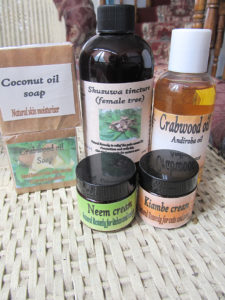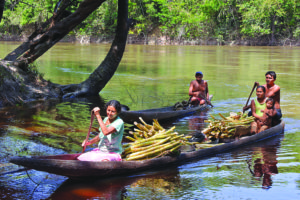Indigenous culture, unlike others, is a process of accommodation with nature. Their concern for ecology and the environment, and the balance of nature, is part of their belief system.


Ecology is woven seamlessly into the fabric of their culture. Everything in the forest and the surrounding area has a role to play in the overall scheme of things and nothing is wasted. They live in harmony with nature and do not adulterate the landscape or endanger plants or wildlife. One example: they once hunted fish for survival only until they were confronted with a market economy when their entire cultural landscape changed.
Their rich indigenous heritage and culture greatly impacted others. Many of the technological contributions of their societies have already been recognised by the native terminology, which has also entered our culture. In Guyana, quite a number of native products became current only after the Europeans and other immigrants settled on the coast: pepperpot, hammocks, balata, medicinal herbs, íte palms, and troolie leaves (for thatching roofs).
In their widely differing environments, indigenous peoples adapted and produced a stream of unique inventions, each one a distinct response to a local necessity: asphyxiating fish with ground leaves and roots of specific plants in the absence of hooks and nets, for example, or bending twigs to mark a trail or preventing one from getting lost in the forest and to mark their route.
It was through these bent twigs in Guyana and an indigenous line as a guide, that the cattle trail was cut (1916-1920) from Surama in the Rupununi to Takama in Berbice. Also, these bent twigs helped explorers find their way in the dense jungles and, enabled the discovery of many Amazonian tribes, bringing them to civilisation.
Some indigenous persons can be superb mimics of animals and bird sounds. They can mislead even the jaguar. They bring the yarrow fish to the surface, for instance, through a slow seducing whistle, and can even reproduce the mating call of the tapir. They bring other fish to the surface by splashing the water in such a way to mimic the falling of ripened seeds. They showed settlers a range of dishes based from the forest plants and animals, e.g., food from root crops like cassava and yams, and oil from turtle eggs.
Their intimate knowledge of forest resources is extensive and remarkable. They can recognise medicinal properties in hundreds of plants – knowledge that is a priceless resource of the rainforest. From oral contraception to insect repellent, scientists are still to analyse the scientific properties of Amazonian plants. Armed with the knowledge of thousands of medicinal plants, shamans and piaimen fought goitre, headaches, malaria, constipation and other illnesses. Ipecac from Amazonian roots cured amoebic dysentery. Quinine from the cinchona bark cured malaria. Curare killed without affecting the heart. These medicinal plants were eagerly sought by the early colonists to supplement the old world’s pharmacies.
Apart from introducing the benefits of forest resources to the world, the indigenous’ greatest contribution to modern Guyana was the help they gave to colonists and subsequent coastlanders in penetrating and understanding its hinterland.
All expeditions into the heart of the country and beyond relied on indigenous skills as guides, hunters, boat hands, woodsmen or canoers knowing every treacherous rapid, jungle trail, mountain, hill, tree, cataract or waterfall. Indeed, it was these expeditions that opened Guyana to its non-indigenous settlers and showed the riches of the interior – forest products, minerals, natural scenes and other phenomena that brought tourists.
Text provided by overseas-based Guyanese author, Lal Balkaran – MBA, FCPA, FCGA, FCMA, CGMA. Balkaran worked as a teacher in the Rupununi in the 1970s and travelled throughout the interior. He is the author of “Encyclopaedia of the Guyanese Amerindians”, “A Photojournal of the Guyanese Amerindians”, “The Rupununi – A Visual Journey” and several documentaries including “Historical and Contemporary Georgetown – Guyana’s Heartbeat”. He can be reached at lalbalkaran@rogers.com



